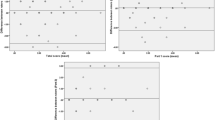Abstract
The Fleming index of dysphagia was used to determine the prevalence of dysphagia in patients in a long-term, neuropsychiatric medical center. Prevalence varied by section, with the ventilator-dependent patients having the highest rate and the chemical-dependent patients having the lowest. The Fleming index appears to be a quick and useful instrument to identify patients who are at risk of dysphagic complications, but further reliability and validity studies are needed to demonstrate its utility.
Similar content being viewed by others
References
Fleming SM: Index of dysphagia: a tool for identifying deglutition problems.Dysphagia 1:206–208, 1987
Trupe EH, Siebens H, Siebens A: Prevalence of feeding and swallowing disorders in a nursing home. Paper presented at the American Congress of Rehabilitation Medicine, Boston, 1984
Groher ME: The prevalence of swallowing disorders in two teaching hospitals.Dysphagia 1:3–6, 1986
Echelard PD, Thoppil E, Melvin JL: Rehabilitation of dysphagia. Paper presented at the American Congress of Rehabilitation Medicine, Boston, 1984
Elpern EH, Jacobs ER, Bone RC: Incidence of aspiration in tracheally intubated adults.Heart & Lung 16:527–531, 1987
Gordon C, Hewer RL, Wade DT: Dysphagia in acute stroke.Br Med J 295:411–414, 1987
Pannell J, Cantieri C, Cherney L: Evaluation of dysphagia in the neurologically impaired. Paper presented at the Illinois Speech-Language Hearing Association, Chicago, 1984
Vels SL, Logemann JL: Incidence and nature of swallowing disorders in CVA patients. Paper presented to the American Speech-Language Hearing Association, Washington, DC, 1985
Winstein CJ: Neurogenic dysphagia: frequency, progression, and outcome in adults following head injury.Phys Ther 63:1992–1997, 1983
Weiden P, Harrigan M: A clinical guide for diagnosing and managing patients with drug-induced dysphagia.Hospital Commun Psychiatry 37:396–398, 1986
Author information
Authors and Affiliations
Rights and permissions
About this article
Cite this article
Layne, K.A., Losinski, D.S., Zenner, P.M. et al. Using the Fleming index of dysphagia to establish prevalence. Dysphagia 4, 39–42 (1989). https://doi.org/10.1007/BF02407401
Issue Date:
DOI: https://doi.org/10.1007/BF02407401




